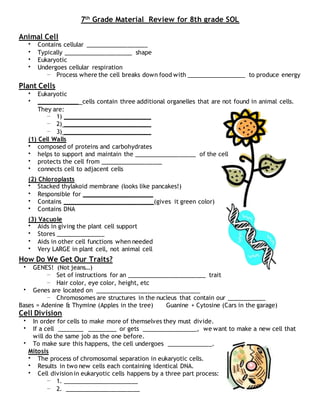
Review Plant and Animal Cells, Cell Division, Photosynthesis, Genetics, and Ecology
- 1. 7th Grade Material Review for 8th grade SOL Animal Cell • Contains cellular ___________________ • Typically _____________________ shape • Eukaryotic • Undergoes cellular respiration – Process where the cell breaks down food with __________________ to produce energy Plant Cells • Eukaryotic • _____________ cells contain three additional organelles that are not found in animal cells. They are: – 1) ___________________________ – 2) ___________________________ – 3) ___________________________ (1) Cell Walls • composed of proteins and carbohydrates • helps to support and maintain the ___________________ of the cell • protects the cell from ___________________ • connects cell to adjacent cells (2) Chloroplasts • Stacked thylakoid membrane (looks like pancakes!) • Responsible for ______________________ • Contains ____________________________(gives it green color) • Contains DNA (3) Vacuole • Aids in giving the plant cell support • Stores _______________ • Aids in other cell functions when needed • Very LARGE in plant cell, not animal cell How Do We Get Our Traits? • GENES! (Not jeans…) – Set of instructions for an ________________________ trait – Hair color, eye color, height, etc • Genes are located on ________________________________ – Chromosomes are structures in the nucleus that contain our ____________ Bases = Adenine & Thymine (Apples in the tree) Guanine + Cytosine (Cars in the garage) Cell Division • In order for cells to make more of themselves they must divide. • If a cell ________ _________ or gets _________________, we want to make a new cell that will do the same job as the one before. • To make sure this happens, the cell undergoes ______________. Mitosis • The process of chromosomal separation in eukaryotic cells. • Results in two new cells each containing identical DNA. • Cell divisionin eukaryotic cells happens by a three part process: – 1. _______________________ – 2. _______________________
- 2. – 3. _______________________ 1. Interphase: Chromosomes are copied. Each chromosome is then two chromatids 2. Mitosis: 4 Phases: – ________________: Chromosomes condense into rodlike structures. – ________________: Chromosomes line up along the equator. – ________________: Chromatids separate and move to opposite sides of the cell. – ________________: Nuclear membrane forms around the sets of chromosomes and mitosis is complete! *PMAT! 3. Cytokinesis: • Divisionof the cytoplasm of the cell. *They are officially 2 _____________________ cells now! “I proposed marriage after Tuesday’s class” � IPMATC Meiosis • Cell Divisionthat results in sex cells (egg and sperm) • Interphase + PMAT x 2 + Cytokinesis • Chromosomes are copied ___________, but the nucleus divides ___________! • The resulting eggs and sperm have _________ the number of chromosomes of a normal body cell. • 46 chromosomes in humans; sex cells should have 23 in each • 23 from Mom and 23 from Dad to get a full set • Math = 46 x 2= 92 / 2 = 46 /2 = 23! Punnett Square : Used to determine offspring genotype and phenotype Heredity Lingo… Genotype vs phenotype *Genotype = Allele combination (codes for a phenotype) ex: Rr, rr *Phenotype = Physical looks ex: red rose, blonde hair Heterozygous vs homozygous *heterozygous = “Different” Rr, Br, Tt *Homozygous = “____________” RR, BB, bb, tt Dominant vs Recessive *Dominant = *Shown with a capital letter “L” “R” “B” *Recessive = *Shownwith a lower case letter “l” “r” “b” *** RR = Dominant Trait Rr = ______________ trait rr = Recessive trait Photosynthesis • Process where plants, algae, and some bacteria are able to make their own food by way of their cells. • It takes carbon dioxide from the air plus water and light energy to make sugar (glucose) and oxygen • *It’s how plants make their own food. Food gives them energy. So, they make their own _______________! How Do Living Things Get Their Energy? • The energy that a living thing gets is from the breakdown of food. • Organisms get their food in one of three ways: Equation for photosynthesis
- 3. – _______________________ – _______________________ – _______________________ Ways of Getting Food • Producer- makes their own food with cells • Consumer- must find their food • Decomposer- breaks down _____________ material to get its nutrients All Living Things are Connected! • Food chain = _________________ that shows how energy in ___________flows from one organism to another • Simple food chains are rare because few organisms eat just one kind of food Food Webs • Food web: diagram that shows the feeding ____________________ between organisms in an ecosystem • Energy moves from one organism to the next in a one-way direction • Any energy not immediately used is stored in its tissues, which can be used by the next consumer Energy Levels • As you move up the pyramid the energy _________________ because the number of organisms decreases. • ________ _______________ is available at higher levels because only energy stored in the tissues of an organism can be transferred to the next level Let’s practice!